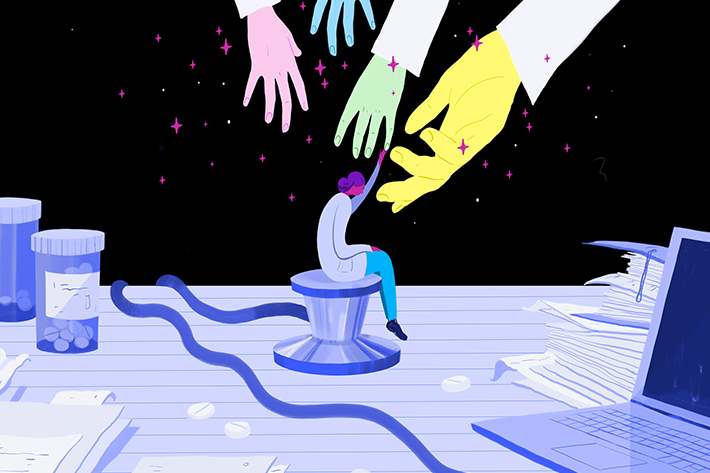
Physician Burnout and Moral Injury: Addressing a Growing Crisis


The Challenge
Physicians are struggling with physician burnout & moral injury, the distress that comes with being systemically prevented from providing patients with the care they need.
Why It Matters
Nurse burnout often leads to:
- Higher turnover
- Lower patient satisfaction
- Worse health outcomes


What You Can Do
- Gather feedback from frontline staff
- Relax burdensome practitioner targets
- Push back against unreasonable requests & regulations
- Lobby for systemic change
It’s no secret that it’s hard to be a physician in the US. A 2018 survey put the “Physician Misery Index” — a measurement of national physician dissatisfaction — at 3.94 out of 5. Meanwhile, a 2022 survey by the American Medical Association found that 52% of respondents were experiencing a great deal of stress. With stats like this, it’s no wonder that physician burnout is such a big problem.
Healthcare leaders usually credit this to burnout: a feeling of exhaustion and/or discontent that is often the result of overworking. But what too many healthcare organizations fail to account for is moral injury, says Dr. Wendy Dean, physician, healthcare executive, and co-founder and president of Moral Injury of Healthcare.
Quality Reviews CEO Edward Shin, MD, recently talked with Dean in a webinar called “Physician Burnout and Moral Injury: Addressing a Growing Crisis” — watch the video above, or read on for the highlights from their conversation.
What Is Moral Injury, & How Does It Contribute to Physician Burnout?
Dean, who became well-known for an article she wrote on the theme in 2018, defines moral injury as the distress physicians experience when they are prevented from providing patients with the care they need due to systemic constraints (such as prior authorizations and excessive administrative tasks).
It contains two separate mechanisms, according to Dean: the transgression of deeply-held
moral beliefs, and betrayal by an authority figure in a high-stakes situation — for example, having COVID-19 protocols relaxed in an area where the virus is raging. It also occurs at three
different levels: personal, professional, and societal.
While healthcare professionals aren’t the only ones who suffer from moral injury — it also occurs in mission-driven professions like education, public defense, and social work — it is common throughout the industry.
Moral Injury vs. Physician Burnout
While moral injury can lead to burnout, they’re not the same thing.
“Burnout says that the individual is unable to tolerate the demands of the system. Moral injury
says the system is broken, not the individual,” Dean said.
And recognizing moral injury is important, as thinking of it as burnout fails to address the real problem.
“It really matters because language is the basis of all the solutions that we develop. If we don’t
have the right diagnosis, then we’re not going to develop the right treatment,” Dean said.
This was something Dean saw firsthand in her time working with the Department of Defense
studying physician burnout and suicide.
“I started thinking, ‘Are we looking at the right thing?’ Because we’ve been assessing and
treating burnout for 20 years, and we’re not making a bit of difference,” Dean said. “When you
make a diagnosis, and your patient comes back after two different treatments and says both of
those treatments have not worked, the humble physician will say, ‘Okay, maybe it’s not the
treatments that are failing this patient — maybe I have the wrong diagnosis.’”
These “treatments” have often included solutions borrowed from corporate America, like yoga,
mindfulness/meditation, and healthy eating. These often work well in other industries,
Dean said, but not in healthcare.
“[Physicians say] ‘I can do all the yoga in the world, I can eat all the salmon salad in the world —
it’s not going to make a difference at my walk-in the next day when I can’t get my patient a CT
scan, have to do three prior authorizations, or can’t refer my patient to the right specialist,” she
explained.
How Healthcare Leaders Can Combat Moral Injury
So if yoga and mindfulness aren’t the solution to moral injury, what is? Dean suggested a few
different ways healthcare leaders could stave off moral injury.
1. Listen to Practitioners.
In healthcare, decisions often come from top admins — but listening to physician feedback is critical.
“Real-time feedback, not just from patients, but also from clinicians, is essential. Because providing that data to leadership” — for example, “I’ve had the same challenge for the past two weeks, and I can’t figure out how to get it fixed” — “is the first step,” Dean said.
These challenges often involve administrative hurdles, making it important to reach out to the administrative staff as well.
It’s beneficial to “[learn] a little bit about what the pressures are on the administrative side, because there are some, and they are legitimate,” Dean said.
Working with both physicians and their administrative counterparts, you can discuss which challenges they each face and how they might be able to come up with solutions that allow physicians to align their work with their values and administrators to meet their needs.
2. Relax Overly Burdensome Targets
Modern US healthcare often requires physicians to spend so much time and energy focusing on performance metrics that they aren’t able to put patient care first.
“We teach medical students and residents ‘the gold standard — and then the second they walk
into a practice they have to compromise it, because they have productivity targets, revenue
generation targets, and leakage and keepage mandates,” Dean said.
And these targets fail to take emergencies into account.
“We’re working on an assembly line model, but assembly lines don’t typically have emergencies that pop up on a regular basis,” Dean said. “We’re not accounting for those routine, reliable emergencies or urgent cases.”
It may go against administrative instincts, but reducing or even getting rid of some of these mandates can help physicians provide better care — which improves both patient and employee satisfaction.
Push Back When Needed
As a previous healthcare executive herself, Dean is well aware of the challenges they face, including the pressure to comply with increasingly strict regulations. In those situations, administrators often feel like their hands are tied — but Dean believes that they can make a difference.
“We sometimes need the weight of an administrator or an executive to shift the system. When that happens, you can have a really powerful impact on your workforce,” Dean said.
Dean cited a couple of examples, including a medical society that successfully lobbied to reduce a training on one form from four hours to just 15 minutes, and a large practice that pushed back against a state request to provide an additional, redundant report.
“Leadership isn’t just to communicate requirements or expectations,” Dean said. “It’s also to be
critical of whether those expectations are reasonable.”
4. Advocate for systemic change
While healthcare leaders do have some power to combat moral injury, what’s really needed are changes to the system as a whole.
“Do I really need to confirm immunizations and go through the domestic abuse questions every single visit for every single clinician? Do [social determinants of health] belong in medical care, or do we need to start shifting some of that cost to social infrastructure?” Dean posited. “I’m not trying to choose one or the other, but I’m saying we really need to streamline the data that we’re collecting.”
There is one metric that Dean believes should be added, however.
“[We should] require that every hospital that takes CMS funds also has clinician wellbeing as part of their executive global scorecard — it also must be linked to executive compensation,” she suggested.
Another area in need of reform is the EMR system. Doctors spend hours of their time in the EMR, taking away time they could use to attend to patients. Hiring medical scribes can be a short-term bandaid, but it’s not a true solution.
“We need to actually redesign the EMR around what the clinician needs rather than what the billing office needs,” Dean suggested.
And perhaps most urgently, we must get rid of prior authorizations, which Dean said have become “completely out of control.”
Dean knows that many of these proposals sound lofty, but she’s not unrealistic. She knows reforming the system will be hard, but also believes it is a fight worth fighting.
“Our goal is to try to shift clinician distress, to reduce the drivers one by one. It is going to be a slow process. But if we continue to chip away at it, I believe it will shift,” Dean said.
What Is Moral Injury?
Dean defines moral injury as the distress physicians experience when they are prevented from providing patients with the care they need due to systemic constraints like:
- Insurance approval hurdles
- Excessive administrative tasks
- Bureaucratic processes
Moral Injury vs. Physician Burnout
Moral injury can lead to burnout, but they’re not the same thing. According to Dean, burnout suggests an individual problem, while moral injury suggests a problem with the system.
Ineffective Solutions for Moral Injury
Over the years, health leaders have borrowed strategies from corporate America designed to
treat burnout, like:
- Encouraging mindfulness/meditation
- Yoga classes
- Education about healthy eating
But these fail to address the systemic roots of moral injury.
Effective Solutions for Moral Injury
- Listen to practitioners: Reach out to frontline practitioners and admins to find out what they need to be successful.
- Relax overly burdensome targets: Reduce or even get rid of targets for things like revenue generation, productivity, and keepage/leakage so physicians can put patient care first.
- Push back when needed: Speak out against unreasonable requests and regulations and propose alternate solutions.
And Above All… Advocate for Systemic Change
Use your influence to lobby for wide-sweeping changes like:
- Redesigning EMRs to be practitioner-first
- Streamlining the data that healthcare organizations are required to report
- Prior authorization reform
“Our goal is to try to shift clinician distress, to reduce the drivers one by one. It is going to be a slow process. But if we continue to chip away at it, I believe it will shift.”
– Wendy Dean, MD








